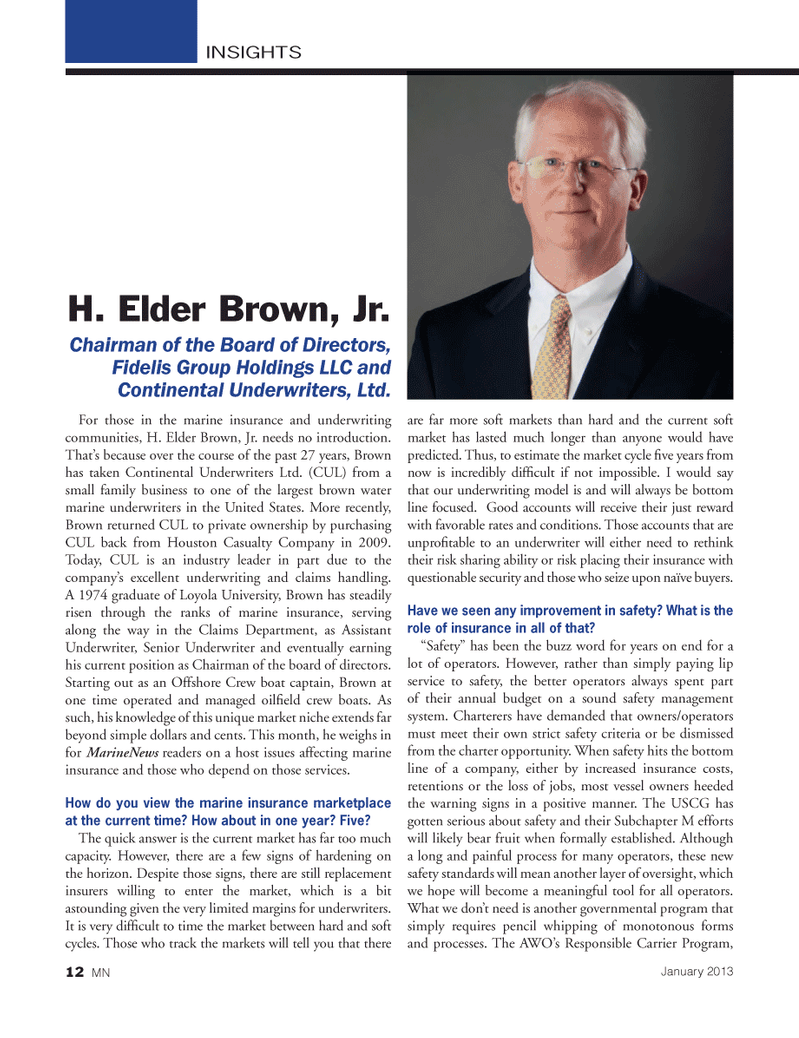
Page 12: of Marine News Magazine (January 2013)
Training and Education
Read this page in Pdf, Flash or Html5 edition of January 2013 Marine News Magazine
For those in the marine insurance and underwriting communities, H. Elder Brown, Jr. needs no introduction. That?s because over the course of the past 27 years, Brown has taken Continental Underwriters Ltd. (CUL) from a small family business to one of the largest brown water marine underwriters in the United States. More recently, Brown returned CUL to private ownership by purchasing CUL back from Houston Casualty Company in 2009. Today, CUL is an industry leader in part due to the company?s excellent underwriting and claims handling. A 1974 graduate of Loyola University, Brown has steadily risen through the ranks of marine insurance, serving along the way in the Claims Department, as Assistant Underwriter, Senior Underwriter and eventually earning his current position as Chairman of the board of directors. Starting out as an Offshore Crew boat captain, Brown at one time operated and managed oil eld crew boats. As such, his knowledge of this unique market niche extends far beyond simple dollars and cents. This month, he weighs in for MarineNews readers on a host issues affecting marine insurance and those who depend on those services. How do you view the marine insurance marketplace at the current time? How about in one year? Five? The quick answer is the current market has far too much capacity. However, there are a few signs of hardening on the horizon. Despite those signs, there are still replacement insurers willing to enter the market, which is a bit astounding given the very limited margins for underwriters. It is very dif cult to time the market between hard and soft cycles. Those who track the markets will tell you that there are far more soft markets than hard and the current soft market has lasted much longer than anyone would have predicted. Thus, to estimate the market cycle ve years from now is incredibly dif cult if not impossible. I would say that our underwriting model is and will always be bottom line focused. Good accounts will receive their just reward with favorable rates and conditions. Those accounts that are unpro table to an underwriter will either need to rethink their risk sharing ability or risk placing their insurance with questionable security and those who seize upon naïve buyers. Have we seen any improvement in safety? What is the role of insurance in all of that? ?Safety? has been the buzz word for years on end for a lot of operators. However, rather than simply paying lip service to safety, the better operators always spent part of their annual budget on a sound safety management system. Charterers have demanded that owners/operators must meet their own strict safety criteria or be dismissed from the charter opportunity. When safety hits the bottom line of a company, either by increased insurance costs, retentions or the loss of jobs, most vessel owners heeded the warning signs in a positive manner. The USCG has gotten serious about safety and their Subchapter M efforts will likely bear fruit when formally established. Although a long and painful process for many operators, these new safety standards will mean another layer of oversight, which we hope will become a meaningful tool for all operators. What we don?t need is another governmental program that simply requires pencil whipping of monotonous forms and processes. The AWO?s Responsible Carrier Program, H. Elder Brown, Jr. Chairman of the Board of Directors, Fidelis Group Holdings LLC and Continental Underwriters, Ltd. INSIGHTS12 MNJanuary 2013 MN Jan2013 Layout 1-17.indd 12MN Jan2013 Layout 1-17.indd 121/2/2013 3:15:39 PM1/2/2013 3:15:39 PM

 11
11

 13
13
